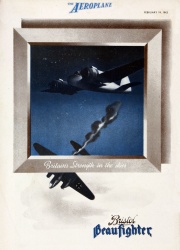Bristol Aeroplane Co: Beaufighter: Difference between revisions
No edit summary |
No edit summary |
||
| Line 16: | Line 16: | ||
[[image:Im19430528Aero-Beaufighter.jpg |thumb|May 1943]] | [[image:Im19430528Aero-Beaufighter.jpg |thumb|May 1943]] | ||
[[image:Im19440810FL-BrisBeau.jpg |thumb| August 1944.]] | [[image:Im19440810FL-BrisBeau.jpg |thumb| August 1944.]] | ||
[[image:Im19450119Aero-Beaufighter.jpg|thumb| Jan 1945.]] | [[image:Im19450119Aero-Beaufighter.jpg|thumb| Jan 1945.]] | ||
[[image:Im19490728FL-BristolBeau.jpg |thumb| July 1949. (Flight 1949/07/28)]] | |||
''Note: This is a sub-section of [[Bristol Aeroplane Co]]. | ''Note: This is a sub-section of [[Bristol Aeroplane Co]]. | ||
Revision as of 17:06, 9 March 2016



















Note: This is a sub-section of Bristol Aeroplane Co.
Type
- Fighter
Designers
Manufacturers
- Bristol Aeroplane Co
- Fairey Aviation Co
- RAF Ringway
- Ministry of Aircraft Production (3,336)
- Rootes Motors (260)
Production Dates
- 1940-1946
Number produced
- 5,928
Engines
The Bristol Type 156 Beaufighter, often referred to as simply the Beau, was a British long-range heavy fighter derivative of the Bristol Aeroplane Company's earlier Beaufort torpedo bomber design. The name Beaufighter is a portmanteau of "Beaufort" and "fighter".
Unlike the Beaufort, the Beaufighter had a long career and served in almost all theatres of war in the Second World War, first as a night fighter, then as a fighter bomber and eventually replacing the Beaufort as a torpedo bomber. A variant was built in Australia by the Department of Aircraft Production (DAP) and was known in Australia as the DAP Beaufighter.

